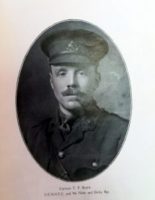There are many elements of university histories bound up with World War I and, with the centenary of the Armistice, the University of Nottingham has published a series of pieces commemorating this date and the impact on staff and students at the University and there are two particular stories I want to highlight here.

The first is the establishment of a Prisoner of War camp at what is now the Sutton Bonington campus of the University of Nottingham. The camp opened in October 1916 and at its peak there were 600 or more German military officers housed there. It seems the officers spent a lot of time planning how to escape, with tunnelling being the most popular option. The full story of one escape attempt is here and tells of a tunnelling effort led by Lieutenant Otto Thelan of the German Army Flying Corps in 1917:
Thelan was a veteran by the time he reached Sutton Bonington, where the tunnel took three months to build through the summer of 1917. It was about 40 yards long and between 12 inches and 2’6’’ high. It ran under the barbed wire fence through sandy soil which had made excavation easier than if it had been clay, especially as the officers had only improvised tools like a jam pot and a piece of zinc shaped like a trowel.
Tunnelling wasn’t an easy option and progress was painfully slow. Only one man could work at a time and he would need to wriggle back along the tunnel because there was unlikely to be room for him to turn around. They also could only work at certain times of the day, mainly between morning and evening roll call, and they had to appear publically looking clean and tidy, and there was the ever present dangers posed by roof falls, explosions of foul air, rats and obviously – being caught.
Eventually it was ready.At 1.30 am on the 25 September Thelan led the group of 22 military officers, complete with their belongings, through the tunnel to emerge in a field of turnips beyond the barbed wire. As the leader, Thelan reached the end of the tunnel first and cut a vertical hole through to the surface. Once Thelan was out, he helped to pull the other men to the surface. They moved quickly across the field and out of the range of the search lights.
The officers headed east in groups of four, aiming for the coast, but were all eventually captured within six days of the break out with one group having made it as far as Chesterfield. Almost all of those involved in the escape were sentenced to 56-60 days of military confinement, which was well above the normal 14 day sentence for simple escape, a reflection of the impact this escape had. The POW camp closed in 1919 and this part of the history of the Sutton Bonington campus is one which is fascinating to learn about.
A registrar at war
One other story is a bit closer to home for me and concerns one of my predecessors as Registrar at the University of Nottingham, Thomas Porteous Black, who was one of at least 23 members of staff from the College to see frontline military action as part of the First World War and the most senior to be killed.

There have been only nine Registrars of the University of Nottingham since its founding as University College Nottingham back in 1881. Black took on the role in 1911, having switched from an academic role as a physics lecturer, at what seems to be the extraordinarily young age of 32. He was responsible for all academic issues, with oversight of the faculty and departmental structure, but also handled all the financial and estate matters.
He helped to found a contingent of the Officer Training Corps at the College and, following the death of his wife in 1914, he volunteered to join the Army as part of the war effort, assuming the rank of Captain before heading out to the Gallipoli Peninsula as part of that ill-fated campaign in the early years of the First World War. He was one of the many casualties in that 10 month long battle and looking back now, over a century later, the involvement of university staff in a theatre of war, as troops, feels utterly extraordinary. Just over 30 years after the foundation of University College and steady growth, in Autumn 1914 everything changed with the outbreak of war. Most male students and staff signed up and most of the institution’s courses were suspended.
Professor John Beckett, in his History of the University, observes that the number of day students during this time declined to only 283 in 1917 and evening students hit their lowest point of 1,144 in 1916. Whilst there were fears the College would close, it demonstrated as many universities have done before and continue to do, incredible resilience and it adapted to meet the new reality despite many hundreds of student cadets joining the army via the OTC. It would be more than another decade before University College moved from its city centre site – now occupied by NTU – to the Trent Building and University Park.
The war hit University College hard and the casualty rates are startling with 229 Nottingham OTC members together with other staff and students killed and over 500 wounded. Six staff didn’t return, among them Thomas Black. We talk today of those who go above and beyond and who demonstrate real commitment but nothing can compare to the dedication and commitment of Thomas Porteous Black and the other students and staff who gave their lives in that terrible conflict.
It really is almost impossible to contemplate the experience of those involved in WWI from our position today. Although we all may feel that our jobs are harder than those of our predecessors, our pace of work faster and stress levels higher, nothing can match the sacrifice of those such as Thomas Black and from higher education institutions everywhere who paid the ultimate price.














fascinating paul
I never knew Sutton Bonnington was a PoW camp – fascinating! Thanks for this Paul.
The image used is one of a fascinating collection of around 40 photographs of the Kegworth and Donington Camps, taken by the company W W Winter between 1916 and 1919. Still owned by the company, they are currently the subject of an HLF Bid and are being extensively researched by a group of local and academic historians. A Symposium to disseminate the findings, will be held at the University’s Sutton Bonington Campus in October, 2019.